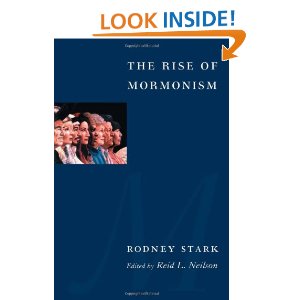I volunteered to give the presentation on Mormons, it sounded like a good idea at the time, for my New Religious Movements class. My presentation pulls form the work of Rodney Stark. At the time of his work, he asserted that the LDS Church is the fastest growing religion in the world. While I had heard Starks work quoted occasionally online, I had not read his book, The Rise of Modern Mormonism. I found the book to be a fascinating and frustrating read.
In his book, and in other journal articles, Stark provides a theory for why new religious movements succeed, and why so many disappear into oblivion. Stark posits that the following conditions must exist for new religious movements to survive, and used Mormonism as his main case study.
- Conversion as Cultural Capital –
- Positive and Negatives of Prophesy (not having too many fail, or not being able to explain the failures)
- Medium Tension (inside/outside markers) right balance (if there is to much or too little tension people leave)
- Legitimate Authority (boundary maintenance) (who belongs who does not)
- Labor Force/Missionaries (additional growth and commitment)
- Adequate Fertility (having enough kids to provide a growing church structure that is not 100% dependent on converts)
- Ecological – LDS Church stronger where other churches are weak (filling in the gap)
- Network Ties -interpersonal attachment, subculture
- Staying Strict “Enough”
- Effective Socialization for youth (not making people too weird)
- Lay Leadership
I found some of these conditions to be rather interesting. I found the issues of socialization something I have been pondering over the last few days. I often wonder how well we are doing at socializing our youth to move into a modern world. I often feel that the gender socialization reflects more a 1950s worldview rather than a modern one. What do you think about this list of conditions necessary to new religious movements to survive? While Stark does contrast other NRM that have NOT survived with Mormonism, he does not adequately compare and contrast other NRM such as the Seventh Day Adventists, and the Jehovah Witnesses, which I think would be essential to strengthening his arguments and theory.
One thing that I found most surprising when reading Starks work was that his growth predictions were actually a rather large range of numbers. For 2015 Stark predicted LDS Church membership would be between, 11,618,000 to 19,172,000. In 2014 there were just over 15,000,000 members (officially on church roles). By 2080 Stark predicted LDS Church growth would be between 63,939,000 to 267,000,000. What do you think of Starks estimates for church growth? Do you think the trends will continue into the future?
If you were to give a presentation on the rise of Modern Mormonism and the possibility of the LDS Church in the future, what would you add? What do you think the Church’s strengths and weakness will be going forward?





I expect I would say something about the fact that a large influx of new missionaries does not seemed to have contributed to a commensurate growth in the number of converts. That may bode poorly for the larger end of Stark’s prediction range. Or, perhaps it just means that we’ll have to find other ways of more effectively using that labor force.
I think the future of the church will be determined in the next few years, by decisions about the succession to Prophet.
It was very noticeable that at least half of the 12 are very frail, an having trouble getting through sentences even with a teleprompter.
What does that look like to young and vital people, what does it look like to non members? Do they show doddering old men on the new meet the Mormons film?
Unless we put in a retirement age for Apostles, or have a mass dying out I think we can appeal to a very limited and very conservative audience.
As Jason says above we are not having much success in the first world. I believe part of the problem is our attitude to gays, and women, and the lack of any obvious revelation from our Prophets. It’s all very well to be unique in having Prophets, but you would expect that that would put us ahead of the curve in some way, and it doesn’t, because they are conservative old men before they are Prophets.
This problem seems to me to be the biggest problem we have in the church at present, preventing us from going to all the world.
Great comment Geoff, cheers from a fellow Aussie (I may be assuming too much based on your name, apologies if I am).
I don’t think organized religion in general will do well at growing in the future. The zeitgeist seems to be moving away from it, to more individualized and personalized expressions of spirituality.
I haven’t read TRMM yet, so I’m curious to know how he gets his numbers. I think the flaw here is that there is no way that I know of to gather membership numbers in a controlled, consistent manner. I’m not trying to be snarky or smarmy about the Church’s policies for numbering its members, but I think the measure isn’t very helpful (and won’t be accurate) if you’re relying on the Church’s own numbers.
I think a much more interesting and helpful measure would be to consistently collect indicators of active members (but such as study would have a smaller scale, as, again, you shouldn’t use the Church’s numbers and it would be a nightmare/an impossibility to organize a consistent monitoring program over a large number of congregations).